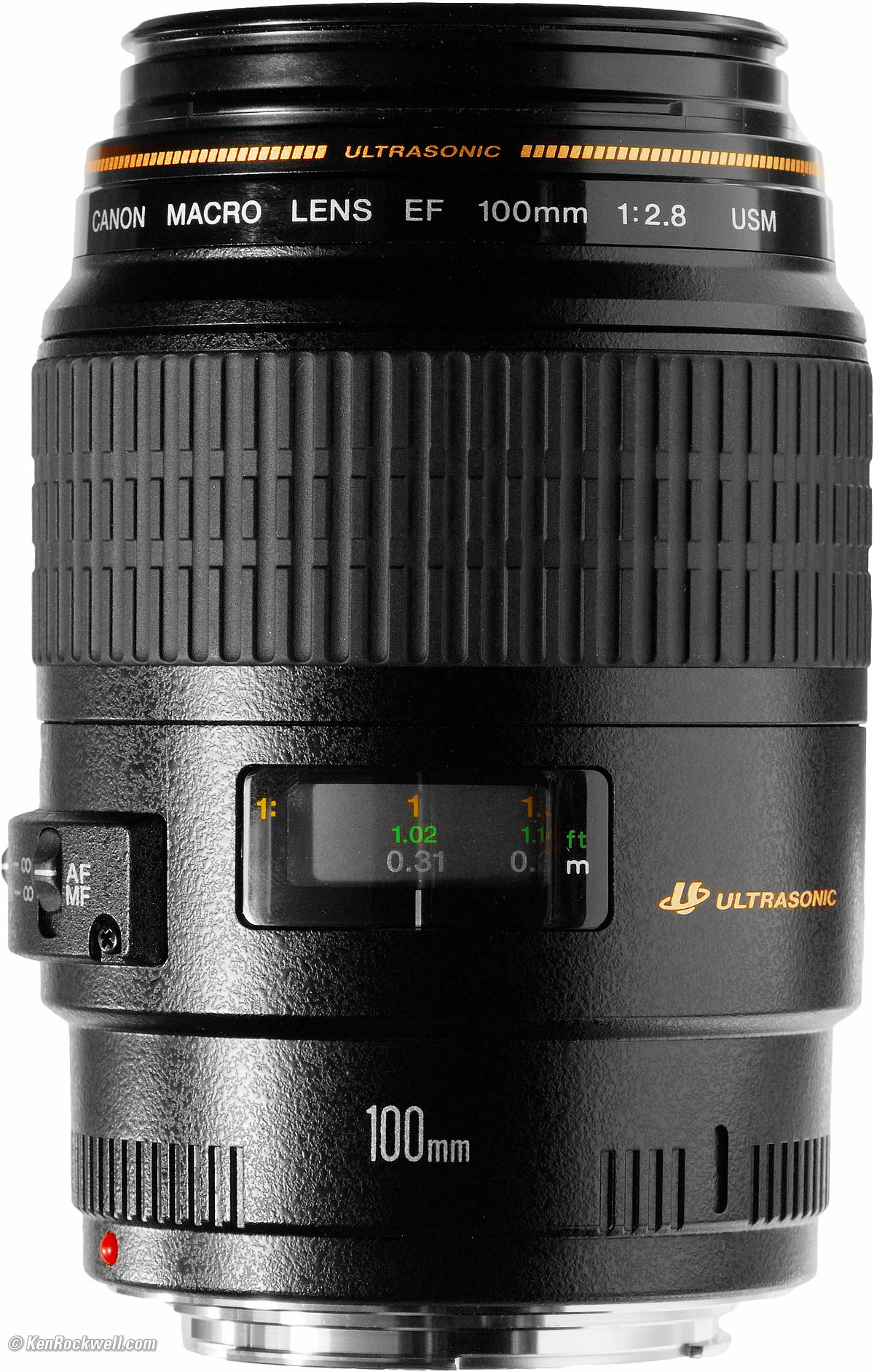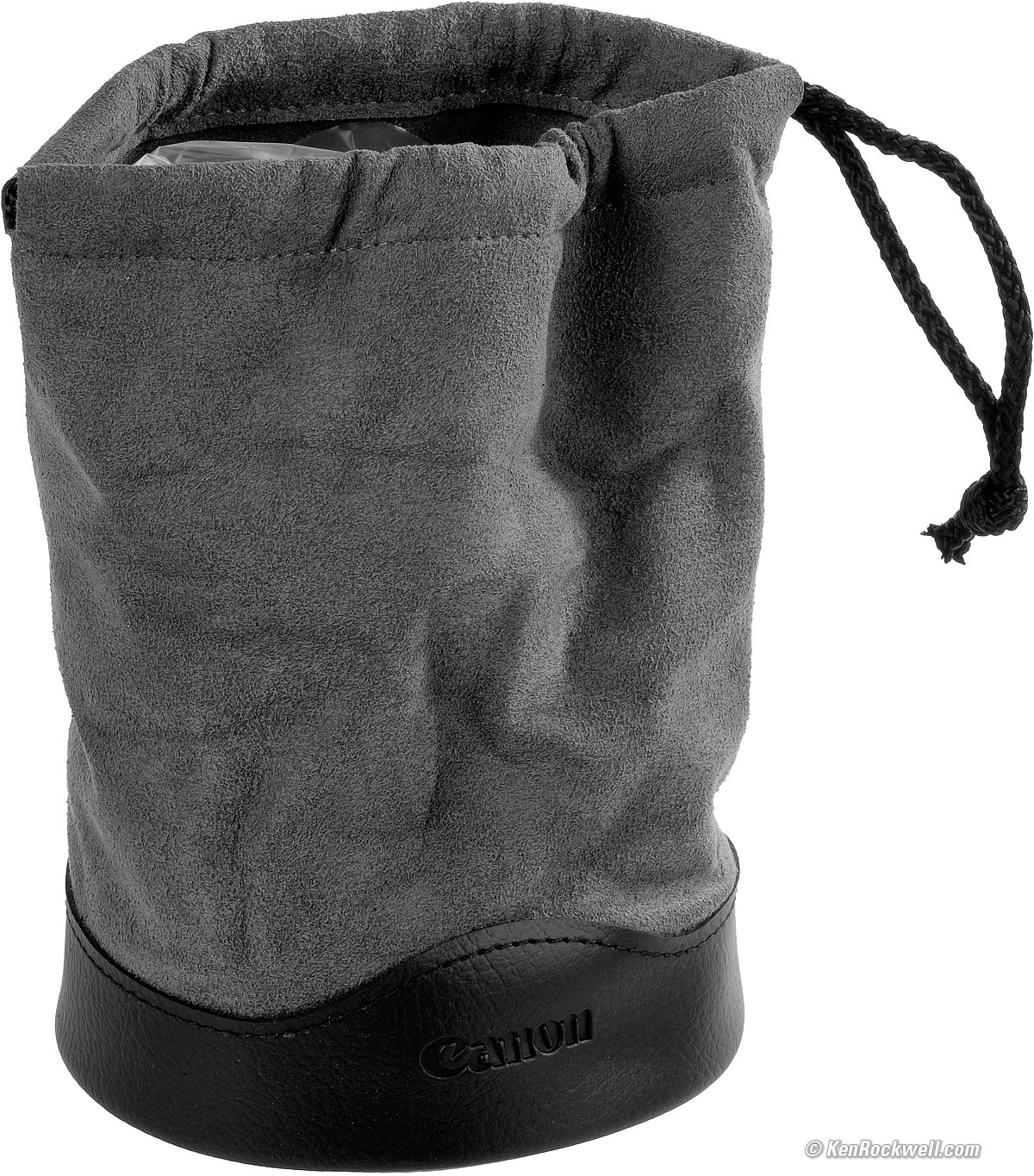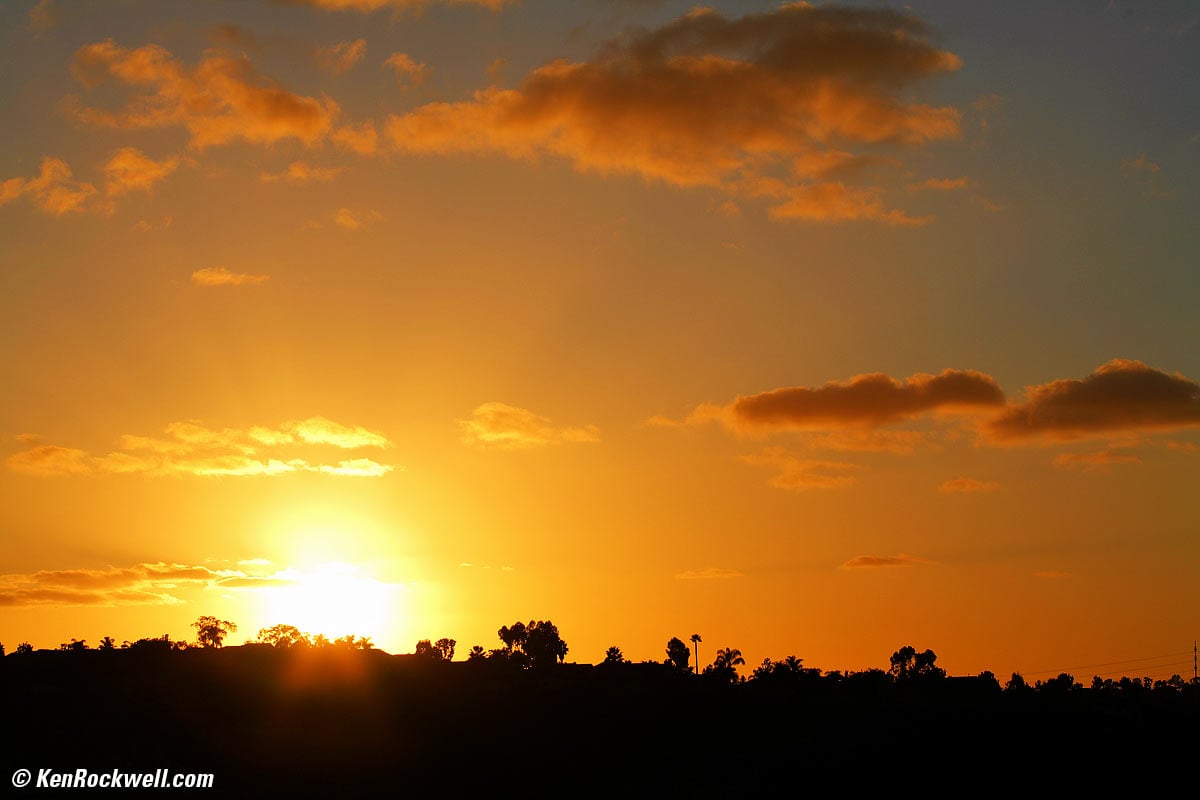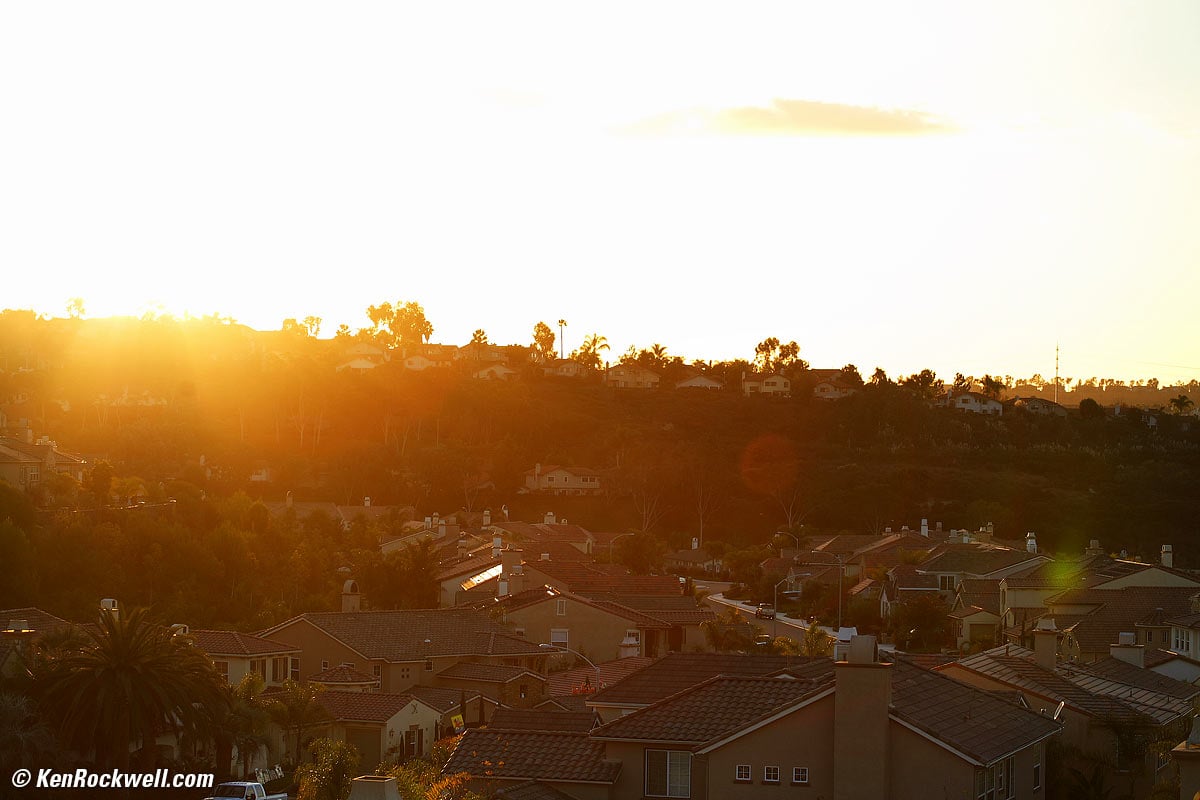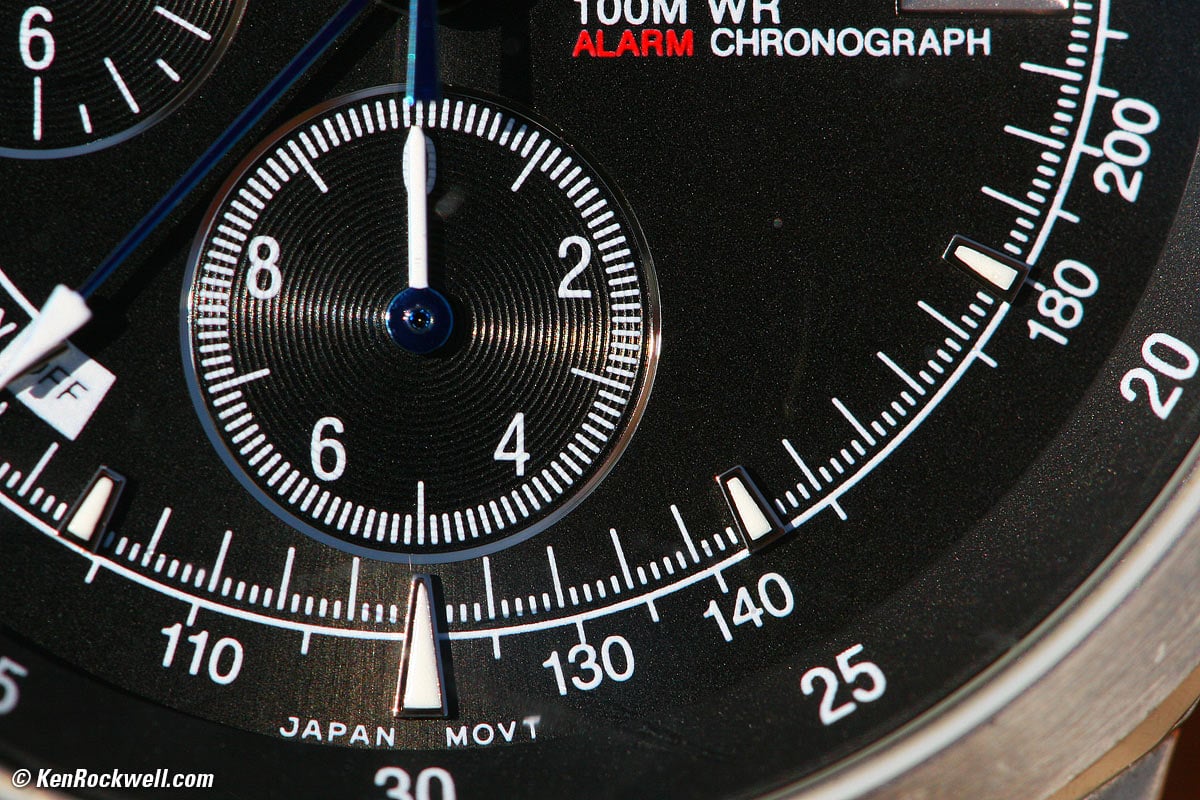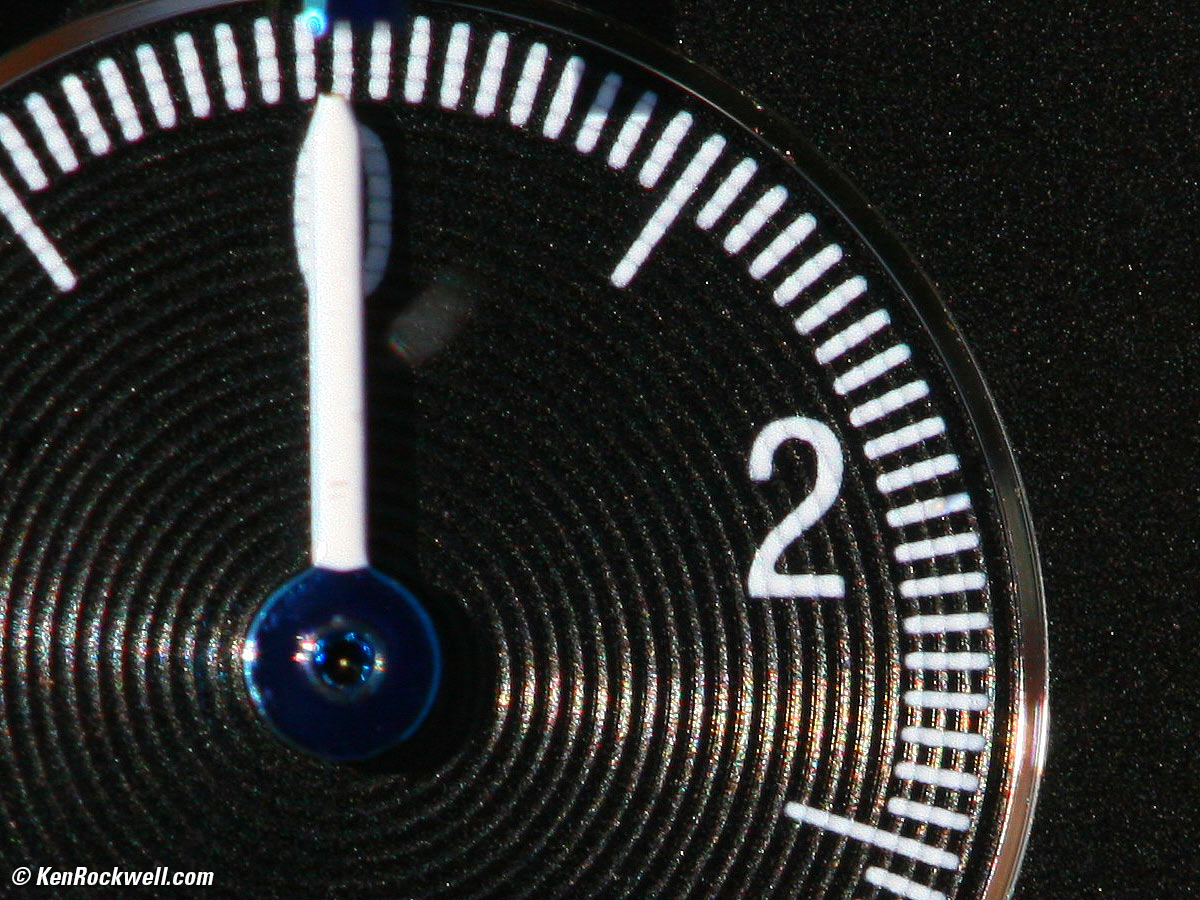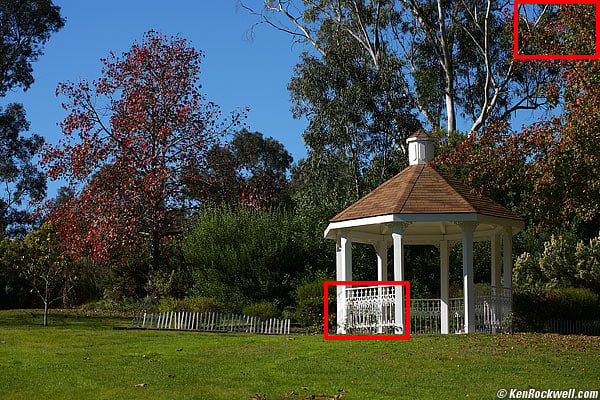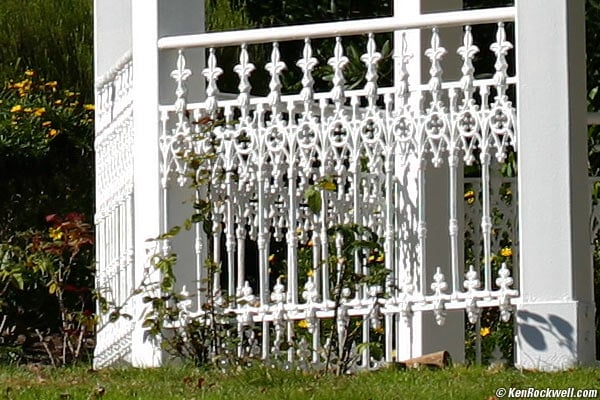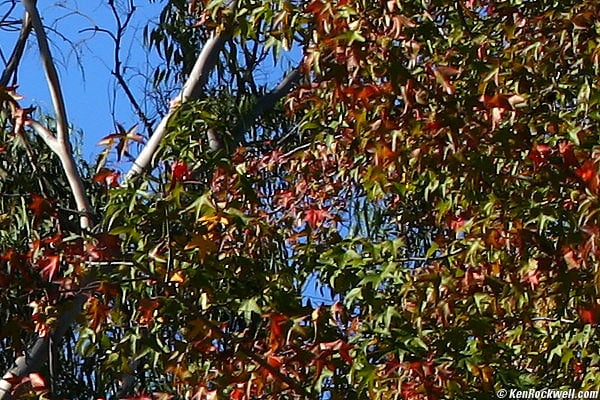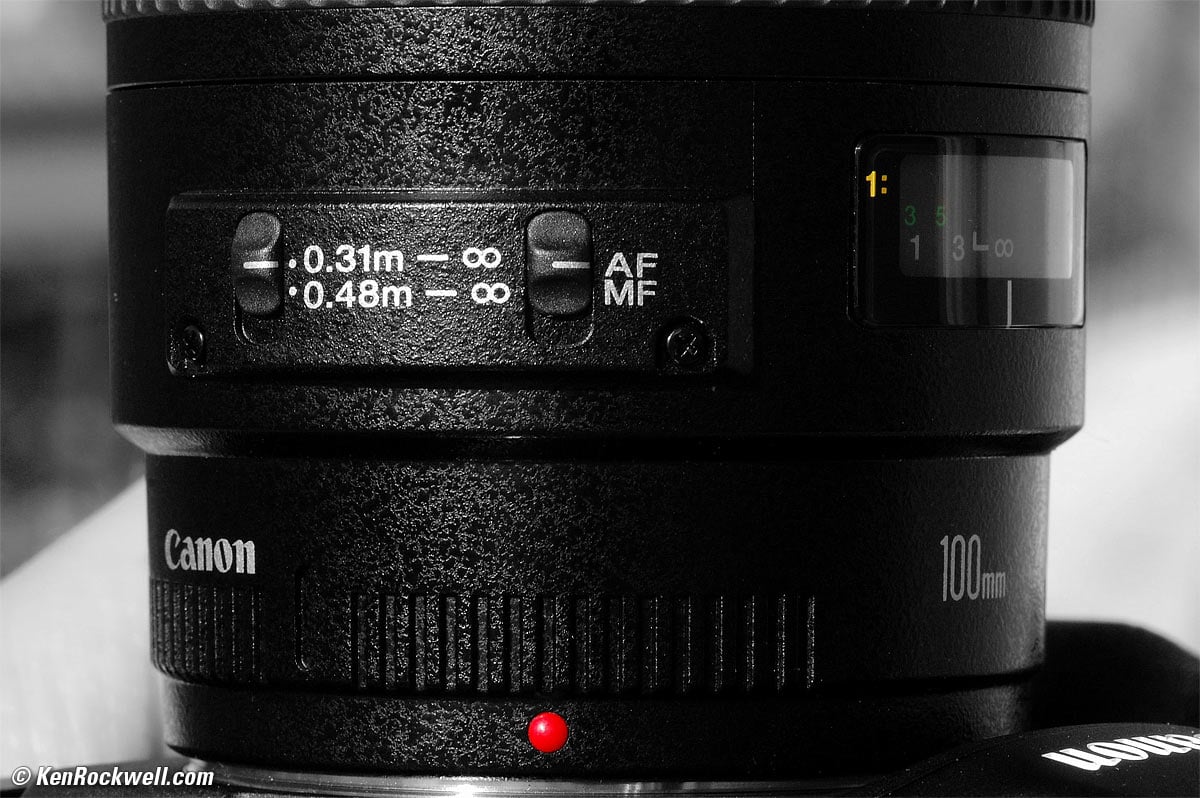Canon EF 100mm f/2.8 Macro USM
Full-Frame 1:1 (2000-2021)
How to Shoot Macro Best Macro Lenses Compared
Introduction New Good Bad Missing
Compatibility Specifications Performance
Compared User's Guide Recommendations
Canon 100mm f/2.8 Macro USM (58mm filters, 20.6 oz./584g, 1:1 macro, $599 or about $375 used). enlarge. I'd get it at Adorama, at Amazon or at B&H , or used at eBay if you know How to Win at eBay. I believe this has been discontinued as of 2021, so while still available new as of April 2021, it may only be available used at eBay soon.
This 100% all-content, junk-free website's biggest source of support is when you use those or any of these links to my personally approved sources I've used myself for way over 100 combined years when you get anything, regardless of the country in which you live — but I receive nothing for my efforts if you get it elsewhere. Canon does not seal its boxes in any way, so never buy at retail or any other source not on my personally approved list since you'll have no way of knowing if you're missing accessories, getting a defective, damaged, returned, non-USA, store demo or used lens — and all of my personally approved sources allow for 100% cash-back returns for at least 30 days if you don't love your new macro. I've used many of these sources since the 1970s because I can try it in my own hands and return it if I don't love it, and because they ship from secure remote warehouses where no one gets to touch your new macro lens before you do. Buy only from the approved sources I've used myself for decades for the best prices, service, return policies and selection.
April 2021 Better Pictures Canon Reviews Mirrorless EF Lenses RF Lenses Flash All Reviews
NEW: All Canon 100mm Lenses Compared
NEWEST: RF 100mm f/2.8L IS USM Macro Review (2021-today)
NEWER: EF 100mm f/2.8L IS USM Macro Review (2009-today)
EF 100/2.8 Macro Review (1990-2000)
EF 100mm f/2 USM Review (1991-2019)
Compared to more 105mm macro lenses
Why fixed lenses take better pictures
Introduction top
|
I buy only from these approved sources. I can't vouch for ads below. |
Introduction New Good Bad Missing
Compatibility Specifications Performance
Compared User's Guide Recommendations
I love this lens. It does everything well and has no weak points.
It's hard to convey this in writing. This is one of those lenses that works so well, efficiently and effortlessly you wonder why all lenses can't be this good.
By comparison, Canon's 50mm macro works well, but sounds like a toy when it focuses. This 100mm focuses instantly in near-silence.
This is Canon's most practical macro lens. The reason you buy it instead of the 50mm is because when you're close to a subject, you can be so close that you can annoy insects or block your own light. This 100mm lets you step back a little further.
This Canon 100mm is less expensive than any of the Nikon 105mm Micro (Macro) lenses, and it works better than either, too. It's easy to use and works great.
This Canon macro doesn't have image stabilization. This isn't a problem, since I and most people shoot serious macro shots with flash or studio strobes. If you need stabilization, you'll want the much more expensive EF 100mm f/2.8L IS USM Macro or RF 100mm f/2.8L IS USM Macro for mirrorless.
For serious macro I use the Canon EF 180mm f/3.5L Macro instead because its longer focal length gives better perspective rendering at close distances; few things look their best from a foot away with a 100mm lens! The 180/3.5 Macro also gives me more working room between camera and subject so I don't block my light.
I'd get my EF 100mm f/2.8 Macro USM at Adorama, at Amazon or at B&H, or used at eBay if you know How to Win at eBay. I believe it's been discontinued as of 2021, so if you want a new one, now's the time to get it.
New since the first EF 100/2.8 Macro of 1990 top
Introduction New Good Bad Missing
Compatibility Specifications Performance
Compared User's Guide Recommendations
 New USM (Ultra-Sonic autofocus Motor) focusses silently.
New USM (Ultra-Sonic autofocus Motor) focusses silently.
 Instant manual-focus override: just turn the big focus ring at any time.
Instant manual-focus override: just turn the big focus ring at any time.
 Internal focusing; doesn't change length as focussed.
Internal focusing; doesn't change length as focussed.
Good top
Introduction New Good Bad Missing
Compatibility Specifications Performance
Compared User's Guide Recommendations
 Spectacular optics!
Spectacular optics!
 Super sharp.
Super sharp.
 No distortion.
No distortion.
 Super-fast autofocus.
Super-fast autofocus.
 Goes to 1:1 in one twist.
Goes to 1:1 in one twist.
 Made in Japan.
Made in Japan.
 100% U.S.A.-based high-quality technical support at (800) OK-CANON.
100% U.S.A.-based high-quality technical support at (800) OK-CANON.
 I'll say it again: spectacular optics!
I'll say it again: spectacular optics!
Bad top
Introduction New Good Bad Missing
Compatibility Specifications Performance
Compared User's Guide Recommendations
 Non-compensating diaphragm: aperture does not automatically correct for light loss as focussed more closely. This means nothing to most people and can be ignored when shooting with TTL metering as almost everyone does, however working with manual exposure or external light meters as I do with studio strobes I have to change my exposure settings as I change distance — even though the light isn't changing! This is obvious because you always can set f/2.8, even at 1:1 where the real maximum aperture is closer to f/5!
Non-compensating diaphragm: aperture does not automatically correct for light loss as focussed more closely. This means nothing to most people and can be ignored when shooting with TTL metering as almost everyone does, however working with manual exposure or external light meters as I do with studio strobes I have to change my exposure settings as I change distance — even though the light isn't changing! This is obvious because you always can set f/2.8, even at 1:1 where the real maximum aperture is closer to f/5!
 For serious macro work, macro-specialists (and I) prefer the EF 180mm f/3.5L USM, because it lets us stand far enough away as not to interfere with lighting or the subject's attitude, and most importantly, gives a more natural perspective because we're able to stand further away from our subjects.
For serious macro work, macro-specialists (and I) prefer the EF 180mm f/3.5L USM, because it lets us stand far enough away as not to interfere with lighting or the subject's attitude, and most importantly, gives a more natural perspective because we're able to stand further away from our subjects.
Missing top
Introduction New Good Bad Missing
Compatibility Specifications Performance
Compared User's Guide Recommendations
 ET-67 hood not included - but not needed, either.
ET-67 hood not included - but not needed, either.
 LP1219 case not included. So?
LP1219 case not included. So?
 Non-compensating diaphragm as explained above.
Non-compensating diaphragm as explained above.
Compatibility top
Introduction New Good Bad Missing
Compatibility Specifications Performance
Compared User's Guide Recommendations
I'd get my EF 100mm f/2.8 Macro USM at Adorama, at Amazon or at B&H, or used at eBay if you know How to Win at eBay. I believe it's been discontinued as of 2021, so if you want a new one, now's the time to get it.
This lens works flawlessly on every Canon DSLR and 35mm SLR made since 1987.
It work flawlessly on every Canon full-frame and every Canon APS-C DSLR.
It also works flawlessly on every 35mm EOS camera, like my Canon EOS 1V, introduced in 2000, and yes, I tried it on my original 1987 Canon EOS 620 and autofocus is fast and works brilliantly.
This isn't Nikon; with Canon, everything just works, even if the camera is over thirty years old.
Use an EF to RF adapter to use this on Canon's full frame mirrorless cameras.
Use the EOS-M adapter to use this on Canon's EOS-M mirrorless cameras.
Specifications top
Introduction New Good Bad Missing
Compatibility Specifications Performance
Compared User's Guide Recommendations
I'd get my EF 100mm f/2.8 Macro USM at Adorama, at Amazon or at B&H, or used at eBay if you know How to Win at eBay. I believe it's been discontinued as of 2021, so if you want a new one, now's the time to get it.
Name specifications top
Canon calls this the CANON MACRO LENS EF 100mm f/2.8 USM:
MACRO: Focuses to just a few inches.
EF: "Electronic Focus," meaning that there is an autofocus motor in the lens itself. All Canon lenses since 1987 have been EF.
USM: Ultra-Sonic Motor, meaning AF is almost silent.
Optics specifications top
Canon EF 100mm f/2.8 Macro Internal Optical Construction.
12 elements in 8 groups.
Multicoated.
Internal focus: nothing moves externally. The front and rear elements never move.
Three internal floating groups for focusing, which is very advanced. If you watch the rear group with the lens off a camera, you'll see it move forwards, then backwards, and then a little forwards again as you focus from infinity to life size. This is the optical design optimizing itself for perfection at every focused distance.
Diaphragm specifications top
8 blades.
Octagonal except at almost wide open at far distances.
Stops down to f/32 at all distances.
Canon claims a secondary diaphragm blocks stray light at f/2.8, increasing contrast when shooting wide-open.
Non-compensating diaphragm: maximum aperture is f/2.8 indicated at all distances. Like all macro lenses it gets slower at close distances, unfortunately the camera doesn't indicate the true f/stop as you focus more closely. You'll have to do the compensation in your head if you're using an external meter! This is unlike my Nikon 105mm AF Micro, which slows to f/5.0 at 1:1 and says so in the camera.
Filters specifications top
Plastic 58mm filter thread.
Does not move or rotate at all.
Coverage specifications top
Full-Frame (24 × 36mm), 35mm film (24 × 36mm) and APS-C (16 × 24mm).
Angles of View specifications top
On full frame at infinity:
24º diagonal.
20º horizontal.
14º vertical.
Focal Length specifications top
100mm.
When used on an APS-C camera, it sees the same angle of view as a 150 mm lens sees when used on a Full-Frame or 35mm camera.
See also Crop Factor.
Autofocus specifications top
No external movement as focussed, so no air or dust is sucked in.
Focus Scale specifications top
Yes.
Infinity Focus Stop specifications top
No.
You have to focus somehow to get precise focus at infinity, just like at every other distance.
Depth of Field Scale specifications top
No.
Infrared Focus Index specifications top
No.
Close Focus specifications top
1.02' (31 cm), measured from the image plane (back of camera).
Working Distance (distance from front of lens to subject) specifications top
At closest focus, the subject is 5.82" (148 mm) from the front of the lens.
Maximum Reproduction Ratio specifications top
1:1 (life size or 1.0 ×).
This means something the same size as your sensor fills the image.
Caps specifications top
Canon E-58 II 58mm front cap, included.
Standard EOS cap rear, included.
Hood specifications top
ET-67, not included (not needed, either).
Case specifications top
Optional Canon LP1219 Lens Sack. bigger.
LP1219 sack, not included.
Size specifications top
3.092" diameter × 4.655" extension from mount, measured.
78.55 mm diameter × 118.25 mm extension from mount, measured.
Rated 3.09" ø maximum diameter × 4.67" extension from flange.
Rated 78.6 mm ø maximum diameter × 118.6 mm extension from flange.
Nothing moves or changes size with focus: it's all internal.
Weight specifications top
20.610 oz (584.2g), measured.
Rated 20.4 oz. (580g).
Announced specifications top
March 2000.
It replaces the non-USM version introduced in April 1990.
The EF 100mm f/2.8L IS USM Macro came out in Fall 2009 and this lens was made along wth it until being discontinued in 2021.
Included specifications top
Lens.
E-58 II 58mm front cap.
Standard EOS cap rear.
1 year warranty.
Canon's Model Numbers specifications top
Product code: 4657A002 (4657A001 in Japan).
Model number: EF10028MU.
JAN code: 4960999-214245.
Price, U. S. A. specifications top
April 2021
$599 at Adorama, at Amazon or at B&H.
About $375 used if you know How to Win at eBay.
June 2013
$550 at Adorama or at Amazon.
About $375 used if you know How to Win at eBay.
Performance top
Introduction New Good Bad Missing
Compatibility Specifications Performance
Compared User's Guide Recommendations
Overall Autofocus Manual Focus Bokeh Distortion
Falloff Film, use on Flare Flash, use with
Lateral Color Fringes Macro Mechanics Serial Number
Sharpness Sound & Noise Stabilization
I'd get my EF 100mm f/2.8 Macro USM at Adorama, at Amazon or at B&H, or used at eBay if you know How to Win at eBay. I believe it's been discontinued as of 2021, so if you want a new one, now's the time to get it.
Overall performance top
This 100mm macro's performance is the performance to which other lenses aspire. I wish everything was this good. You can use this lens as a reference against which to compare everything else.
It's also a pleasure to use and well made.
This lens will make photos limited only by your skill and imagination.
Autofocus performance top
Nothing external moves during focus. The length never changes, even at life size. My Nikon 105mm f/2.8 AF-D gets much longer as it focuses more closely.
The Canon 100mm has three internal floating groups for focusing, which is very advanced. If you watch the rear group with the lens off a camera, you'll see it move forwards, then backwards, and then a little forwards again as you focus from infinity to life size.
Autofocus Speed
AF is fast!! It's much faster than my Nikon 105mm AF. It's so fast that it's useful for some macro shooting. For most macro shooting we focus manually and move the camera back and forth while chasing moving subjects.
On my 5D it's just about instantaneous. It's almost scary!
If you have it focused way out of range it can get confused, but so long as you have a real subject and some light you're fine. Turn the manual ring to get it in range and it will take it from there.
If you're in the dark you're in trouble with a 30D. The 30D has no AF assist light - it uses the flash! The 30D annoys the heck out of live subjects because it fires numerous flash bursts to light the subject to help focusing. It doesn't focus well this way, but does a bang-up job of annoying your subjects. You may even get thrown out, as my wife did while I was trying to photograph her dogs since she thought I was blinding them.
It seems a little better on my 5D, which has no flash for assist. It slows down if it's dark to try to find the subject.
Be sure to have at least a reasonable amount of ambient light (more like LV7 than LV1) if you want to autofocus well.
Autofocus Accuracy
Autofocus accuracy is astounding: it's dead on at f/2.8 at every distance. Bravo!
There is a catch: on a Rebel XT at f/2.8 at infinity it focuses a bit in front of the subject. It's fine on my 5D.
You have to look very hard to see any of this; it works great.
Hunting and Hanging
It is common with all AF macro lenses that often your next shot will require a completely different end of the focus range. When it's that far out of focus, the AF system can simply give up and not focus at all.
Presuming you have your camera set to the appropriate Cfn menu option, I could never get AF to hang or to hunt. It simply went where it needed, and bang!, perfect focus.
A menu item that could lead to your camera getting stuck and not autofocusing if it's way out of focus is "AF/Drive when AF impossible." (It's at MENU > AF page 4 > Lens drive when AF impossible > Continue focus search ON in the R5 and C.Fn. III #1 on the 5D Mark II, for instance. Other cameras may call it something different, or not have that option at all.) Set this option to FOCUS SEARCH ON so that the camera can keep looking if it can't see what to do. Set this to OFF, and if the image is way out of focus with a macro, the camera will simply hang and give up, unless you help it out with the manual focus ring first.
Manual Focus performance top
Manual focus is easy! Just grab the focus ring at any time. Switching is automatic and instantaneous. It's much better than my Nikon 105mm AF, which requires dorky manual switches to swap modes. I haven't compared it to the new Nikon 105mm AFS VR.
Manual focus moves in the opposite direction from Nikon. Don't try this if you use both systems.
Bokeh performance top
Bokeh, the feel, character or quality of out-of-focus areas as opposed to how far out of focus they are, is neutral. At f/2.8 it's a tiny bit negative, but otherwise very neutral.
You will see the octagonal diaphragm if you look for it.
It's a pleasant lens to use for portraits presuming you want a sharp subject. Look out: it's so sharp it will be very obvious what's in focus and what's not unless you use a soft filter. This ain't no stinking lensbaby.
Distortion performance top
It has no distortion at any distance between infinity and 1:1, except at around 15 - 20' (5m) on a full-frame or film camera. This means I can blow it up to 100%, drop a guide on a straight line along an edge in Photoshop, and it doesn't waver. I can't see any distortion even at 15' on the 1.6x cameras.
At 15' on a full-frame camera you can use about +0.5 in Photoshop CS2's lens distortion filter to correct the slight barrel distortion. If distortion is critical, you also could get closer or farther away. Even at it's worst it's better than most other lenses, and certainly better than zooms.
This isn't a problem: macro is for close distances where it has no distortion, and used at infinity it goes away, too.
This is excellent, and as expected for a macro lens.
Falloff performance top
It is very resistant to falloff, even measured on a full-frame camera. This is excellent performance!
Performance gets better as you get closer, and even at infinity, falloff is gone just a stop or two from full aperture. At closer distances it goes away even at wide apertures.
Here are shots of an Expodisc on a full-frame camera. This is a deviously tough test which shows even the slightest falloff. You'll never see it this way in normal photography. Ignore the minor exposure variations between frames.
Canon EF 100mm f/2.8 USM Macro falloff on full frame, no correction.
|
This will be even better on an ordinary 1.6x camera since only the middle of the frame is used. On these popular cameras, there is a little falloff at f/2.8 at infinity, and it's gone completely by f/4. There is none at 1:1, even at f/2.8!
Even if it were bad, falloff can help in portraits and many other subjects, since falloff makes a better picture by concentrating the viewer's attention on the subject and away from the corners.
For photos of blank sky or brick walls falloff is bad, but so are photos of blank skies!
This lens has excellent freedom from falloff.
Use on 35mm Cameras performance top
This lens is designed for film and full frame cameras, and it also works great on every other Canon digital camera. Knock yourself out; you're not going to find any flaws.
Flare & Ghosts performance top
There are no flare or ghosts with any shot with a light source in the image, so long as it's not so insanely bright that you can't safely look through the finder.
If you devise some crazy test you can get a little flare, but after I ran this test, I'm still half blind in my finder eye as I type this. Serves me right!
Bright enough to leave me blind in one eye for an hour, and no flare!
The lack of flare hides just how insanely bright the sun was. The 5D easily handles the overload of the disk of the sun, so this images doesn't convey how far I went to try to get this lens to flare. It was a clear sky after a rain, and about as bright as noon. Even dropping the exposure to try to see the flare, I couldn't.
The only way I could get the Canon 100mm macro to flare was to increase the exposure four stops and tilt down to see the land on the bottom. Of course this completely obliterates the sky, so you'd never, ever need to do this. You'd either add 50 megawatts and 50 genny trucks of fill or use an ND grad, either of which, along with your change in exposure, would drop out the flare.
If you knew how bright the sun was here, you'd understand. Take my word for it: I don't see how I'd ever get this lens to flare if I wasn't deliberately trying.
Use with Flash performance top
There are no shadows, even at 1:1, with the built-in flashes.
I get good results with a 30D's built-in flash. I get crummy (inconsistent)) exposure with the XTi's built-in flash. I'm unsure if this really is related to the cameras, or just what I saw with the few dozen shots I fired off around the house for each. It's not like Nikon, which is always dead-on.
I need to compensate the flash if the subject is dark or light, which is worse than the Nikon system.
Lateral Color Fringes performance top
Even without automatic correction there's none.
On a 1.6x camera or 5D, none! You can see an example below under sharpness.
Patio furniture photographers rejoice!
Macro Performance performance top
This lens is all about macro. As expected, it excels!
This is shot on a Rebel XT. It does the same thing on the 20D and 30D. On a 5D the full field is larger, since the 5D has a larger sensor. On an XTi the 100% crop would be a little closer. No surprises here; I show this so you can compare with other regular lenses macro shots of my watch.
At close focus limit, 1:1 (complete image).
1,200 x 900 pixel (2.9x) crop. This is the small dial in the center of the above image!
This looks great!
The top shot is my standard target: the watch on my wrist. That's the full image, which at life size on the sensor means that an area 15 x 22mm (2/3 x 1") fills the image. As seen on your screen, the top full image is 6x life size, and the bottom crop is 35 times larger than life in each dimension!
My watch isn't printed as well as this lens resolves, and its magnifying crystal is of poorer quality than this lens. This magnifying crystal leads to the slight red/blue fringes on the side markings. It's not from the macro lens!
The depth of field, even at f/8 in these shots, is so narrow that the little hand shown on the tiny dial is out of focus, and it's only a few tenths of a millimeter above the dial, way below the other hands that fly over it!
It takes practice to get this shot this good.
My results with macro lenses are more limited by my skill than the quality of this lens.
Mechanical Quality performance top
Plastic exterior and switches.
Metal mount.
Internals unknown, looks mostly plastic and metal.
I like this: it uses plastic where it can to save weight, and metal where it needs to.
Made in Japan.
Serial Number performance top
The serial number is on the inside of back of the lens, on the back of the mount opposite the electrical contacts.
Sharpness performance top
It's insanely good! I've never gotten sharper images anywhere. Forget the tables, have a look at these 100% crops from my 5D, or click to download the original 5MB file to see for yourself:
Full-frame Image from my 5D. Original file (5MB).
600x 400 pixel (7.3x) crop from lower center.
600x 400 pixel (7.3x) crop from very top right corner.
These unsharpened crops looks good enough to use as is! These were at ISO 50, 1/400 at f/6.3, hand held. If they aren't sharp enough for you, here's the top right corner sharpened a bit:
600x 400 pixel (7.3x) crop from very top right corner, sharpened.
If I showed the entire image at this 100% magnification you would need a 44" (1.1m) wide screen to see it!
It's this sharp wide open, too. Just watch the focus.
Your skill will be your biggest barrier to sharp images, not this lens. Diffraction is usually the sharpness-limiting factor for all lenses, especially digital SLRs, at about f/11 and above. See also How Sharpness Varies with Aperture.
Lens sharpness has nothing to do with picture sharpness; every lens made in the past 100 years is more than sharp enough to make super-sharp pictures if you know what you're doing. The only limitation to picture sharpness is your skill as a photographer. It's the least talented who spend the most time worrying about lens sharpness and blame crummy pictures on their equipment rather than themselves. Skilled photographers make great images with whatever camera is in their hands; I've made some of my best images of all time with an irreparably broken camera! Most pixels are thrown away before you see them, but camera makers don't want you to know that.
If you're not getting ultra-sharp pictures with this, be sure not to shoot at f/11 or smaller where all lenses are softer due to diffraction, always shoot at ISO 100 or below because cameras become softer at ISO 200 and above, avoid shooting across long distances over land which can lead to atmospheric heat shimmer, be sure everything is in perfect focus, set your camera's sharpening as you want it (I set mine to the maximum) and be sure nothing is moving, either camera or subject. If you want to ensure a soft image with any lens, shoot at f/16 or smaller at ISO 1,600 or above at default sharpening in daylight of subjects at differing distances in the same image.
People worry waaaaay too much about sharpness. It's not 1968 anymore when lenses often weren't that sharp and there could be significant differences among them; today they are all pretty much equally fantastic.
Canon RF 24-105mm MTF wide-open at 10 cyc/mm (black) and 30 cyc/mm (blue). Sagittal (solid) and meridional (dashed).
Canon EF 100mm f/2.8 Macro USM MTF.
On a 30D at 100%:
Letters correspond to center - corner. The corners are the corners of a 1.6x sensor 30D. Possible ratings are E - VG - G - F - P. These are subjective. Don't fret over differences between adjacent grades.
f/2.8 |
f/4 |
f/5.6 |
f/8 |
f/11 |
|
| Infinity | VG - VG* |
E - E |
E - E |
E - E |
E - E |
| 3' / 1m (1:10) | E - E |
E - E |
E - E |
E - E |
E - E |
| 1.5' / 50cm (1:3) | E - E |
E - E |
E - E |
*watch the focus, it can focus in front of the subject sometimes.
On a full-frame 5D:
Letters correspond to center - side - corner. Possible ratings are E - VG - G - F - P. These are subjective. Don't fret over differences between adjacent grades.
f/2.8 |
f/4 |
f/5.6 |
f/8 |
f/11 |
|
| Infinity | E - E - VG |
E - E - E* |
E - E - E |
E - E - E |
E - E - E |
*watch the focus, it can focus in front of the subject sometimes.
Sound and Noise performance top
Auto Focus: Quiet plastic sliding on plastic.
Manual Focus: Plastic sliding on plastic.
Stabilization performance top
The Canon 100mm f/2.8 Macro has no Image Stabilization, so be careful hand held in anything but the best light. Then again, as you saw above I get superb results hand held and those were shot at ISO 50, so it's not that big a deal unless you need smaller apertures for depth of field
TIP: In dim light, fire several shots and pick the sharpest. Blur is a random event, so if you fire enough shots, you'll eventually get a sharp one even at very slow speeds.
Compared top
Introduction New Good Bad Missing
Compatibility Specifications Performance
Compared User's Guide Recommendations
I'd get my EF 100mm f/2.8 Macro USM at Adorama, at Amazon or at B&H, or used at eBay if you know How to Win at eBay. I believe it's been discontinued as of 2021, so if you want a new one, now's the time to get it.
NEW: All Canon 100mm Lenses Compared
User's Guide top
Introduction New Good Bad Missing
Compatibility Specifications Performance
Compared User's Guide Recommendations
I'd get my EF 100mm f/2.8 Macro USM at Adorama, at Amazon or at B&H, or used at eBay if you know How to Win at eBay. I believe it's been discontinued as of 2021, so if you want a new one, now's the time to get it.
Manual-Focus Override user's guide top
Just turn the mechaincal focus ring at any time. Of course if your camera is set to SERVO AF it will probably keep trying to focus itself; be sude you're in ONE SHOT and it's locked befoe you try to focus manuallly — but it does always respond.
Canon 100mm Macro Focus Limiter and Mode Switches.
0.31m-∞ / 0.48m-∞ Switch user's guide top
This is a focus limiter.
Leave it in 0.31m-∞.
The 0.48m-∞ position prevents the lens from autofocusing closer than 0.48 meters (1.6 feet). Use this setting only if you're having a problem with the lens attempting to focus on irrelevant close items, or if for some reason the lens is "hunting" from near to far looking for distant subjects.
AF - MF Switch user's guide top
AF: Auto Focus, with manual override anytime you grab the focus ring. Leave it here.
MF: Manual Focus only. Use this if you don't want the autofocus system to focus the lens.
Recommendations top
Introduction New Good Bad Missing
Compatibility Specifications Performance
Compared User's Guide Recommendations
I'd get my EF 100mm f/2.8 Macro USM at Adorama, at Amazon or at B&H, or used at eBay if you know How to Win at eBay. I believe it's been discontinued as of 2021, so if you want a new one, now's the time to get it.
If you need a macro for any Canon mirrorless or digital or 35mm Canon SLR this is it, and the price is right, too! You'll need an EF to RF adapter ring to use it on mirrorless.
For serious macro I use the Canon EF 180mm f/3.5L Macro instead because its longer focal length gives better perspective rendering at close distances; few things look their best from a foot away with a 100mm lens! The 180/3.5 Macro also gives me more working room between camera and subject so I don't block my light.
If you want the sharpest possible shots of real three-dimensional subjects up close, shoot at f/32 or otherwise very little is in focus. Do your best to get the subject flat so it all can be reasonably in focus; a pro friend of mine who gets published in Ranger Rick (it's more competitive to get published in Ranger Rick than in National Geographic) spends a lot of time making butterflies lie flat so the images show every scale on their wings. This has nothing to do with lens sharpness and everything to do with getting the subject as flat as possible; there is NO depth of field at macro distances.
Use studio strobes, or use flashes mounted close to the lens, so you 1.) have plenty of light to shoot at f/16 to f/32, and 2.) the instantaneous flash eliminates camera shake. Shooting hand-held by available light is a recipe for macro disaster due to both slow shutter speeds and larger apertures and their resulting lack of depth-of-field.
I use a clear (UV) protective filter instead of a cap so I'm always ready to shoot instantly. I only use a cap when I throw this in a bag with other gear without padding — which is never. The UV filter never gets in the way, and never gets lost, either.
The very best protective filter is the Hoya multicoated HD3 58mm UV which uses hardened glass and repels dirt and fingerprints.
For less money, the B+W 58mm 010 is an excellent filter, as are the multicoated version and the basic multicoated Hoya filters, but the Hoya HD3 is the toughest and the best.
For color slides like Fuji Velvia 50, I'd use a 58mm Heliopan 81A outdoors.
To make clouds look natural with B&W film outdoors I use a 58mm Hoya HMC K2 Yellow, or usually a 58mm Hoya HMC YA3 Orange for a stronger effect, or a 58mm Hoya HMC Red 25 for the most dramatic skies or to hide skin imperfections.
Filters last a lifetime, so you may as well get the best. The Hoya HD3 stays cleaner than the others since it repels oil and dirt.
All these filters are just as sharp and take the same pictures, the difference is how much abuse they'll take and stay clean and stay in one piece. Since filters last a lifetime or more, there's no reason not to buy the best as it will last you for the next 40 years. Filters aren't throwaways like digital cameras which we replace every few years, like it or not. I'm still using filters I bought back in the 1970s!
Thanks
Many thanks to my friend Dr. Jim Chen from our local photo club, who loaned his lens to me.
© Ken Rockwell. All rights reserved. Tous droits réservés. Alle Rechte vorbehalten. Ken Rockwell® is a registered trademark.
Help Me Help You
I support my growing family through this website, as crazy as it might seem.
The biggest help is when you use any of these links when you get anything. It costs you nothing, and is this site's, and thus my family's, biggest source of support. These places always have the best prices and service, which is why I've used them since before this website existed. I recommend them all personally.
If you find this page as helpful as a book you might have had to buy or a workshop you may have had to take, feel free to help me continue helping everyone.
If you've gotten your gear through one of my links or helped otherwise, you're family. It's great people like you who allow me to keep adding to this site full-time. Thanks!
If you haven't helped yet, please do, and consider helping me with a gift of $5.00.
As this page is copyrighted and formally registered, it is unlawful to make copies, especially in the form of printouts for personal use. If you wish to make a printout for personal use, you are granted one-time permission only if you PayPal me $5.00 per printout or part thereof. Thank you!
Thanks for reading!
Ken.
